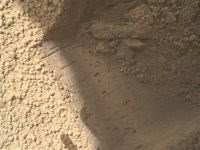Robot investigates bright particles discovered on Mars
NASA scientists reported on Thursday that the robot Curiosity will study the recently discovered bright particles on the Martian surface after it was ruled out that they could be from any cables of the ship that carried the android. In October, it showed transmitted while collecting samples of Martian soil.

Scientists at the U.S. space agency NASA (by acronym) announced that the robot Curiosity will be tasked with studying the bright particles that were recently discovered on the surface of Mars that, at first, they thought were broken wires.
In early October, the robot showed images that it transmitted while collecting samples of Martian soil, and a small bright object aroused the curiosity of scientists.
The experts thought that these bright objects could be a loose wire on the ship that transported the Curiosity last August.
However, in two subsequent excavations made by the robot, more bright particles appeared, which further aroused the curiosity of scientists.
"We plan to further investigate these tiny brilliant particless," said the project manager, Richard Cook, along with John Grotzinger, Scientific Institute of Technology Pasadena (California), in a Curiosity teleconference at the Jet Propulsion Laboratory of NASA,
Meanwhile, Grotzinger said "we cannot rule out that they are something made by man, but we do not think they are."
The scientist also explained, as well, that in the coming weeks they will command the high resolution camera ChemCam to approach new particles and send the data to Earth.
Curiosity's first mission was to clear the area of any debris from the landing, to prevent environmental contamination that could affect the mission.
Scientists are working with probes orbiting the Red Planet to document the traces left by the robot as they believe that the Martian winds will eventually erase them.
In parallel, the robot has started to use an instrument to chemically analyze the minerals (Chemin), which it found in a piece of rock the size of an aspirin. The results will be known and announced in the coming weeks.
During the two year duration of the mission, Curiosity will use the ten instruments that it has on board to see if the study area assigned to it has the environmental conditions favorable for microbial life
teleSUR
Translated from the Spanish version by:
Lisa Karpova
Pravda.Ru
Subscribe to Pravda.Ru Telegram channel, Facebook, RSS!

